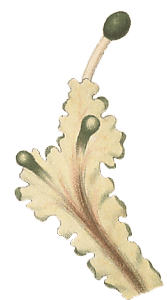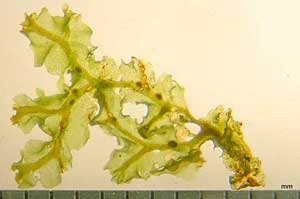
Ecology
Bryophytes and cyanobacteria
Nitrogen is essential for life on earth. All amino acids contain the element and amino acids are the building blocks from which proteins are made. Nitrogen is very common and gaseous nitrogen makes up about 80% of the earth’s atmosphere. Unfortunately, atmospheric nitrogen is not directly usable by living organisms. It needs to be chemically transformed, or fixed, before it can be used. There are very few organisms that are able to fix atmospheric nitrogen. Amongst the organisms that can do so are the cyanobacteria, sometimes incorrectly referred to as blue-green algae, which can be found free-living or in symbiotic associations with other organisms. Within cyanobacteria nitrogen fixation occurs in specialized, thick-walled cells called heterocysts. The heterocysts don’t contain chlorophyll, so no photosynthesis takes place in them. A hormogonium is a filament composed of a number of non-heterocyst cells. Hormogonia that fragment from a parent cyanobacterium can move, by gliding, over a wetable surface and so disperse. Hormogonia can form new heterocysts and so begin the creation of new cyanobacterial colonies.
 Dendroceros crispatus with Nostoc cavities |
Cyanobacteria form a variety of associations with bryophytes ranging from the almost accidental to very close symbioses. Nostoc is a widespread cyanobacterial genus that is a common symbiont and the association between Nostoc and hornworts is an excellent example of a close symbiosis. Within a hornwort thallus there are Nostoc cavities which hold Nostoc cells. The photo shows a thallus of the hornwort Dendroceros crispatus. The dark dots on the thallus are Nostoc cavities, each under a half millimetre in diameter.
The thallose liverwort Blasia pusilla has similar cyanobacterial cavities. Studies of Blasia pusilla and the hornwort Anthoceros punctatus have shown that when starved of nitrogen these bryophytes release hormogonia-inducing chemicals to their surroundings. These induce hormogonia formation in any nearby free-living Nostoc colonies. The bryophytes also release hormogonia-attracting chemicals which help guide the hormogonia into the appropriate cavities. By these means the two bryophytes increase their chances of being infected from any nearby, free-living colonies. The mobile, filamentous hormogonia are the means by which Nostoc enters the bryophytes, the immobile parental filaments being unable to do so. Experimental evidence indicates that the bryophytes release chemical hormogonia-repressing factors into the Nostoc cavities to suppress hormogonia and promote heterocyst creation instead. In free-living cyanobacteria the heterocysts make up 2-5% of all cells. Within the Nostoc cavities up to 60% of the cyanobacterial cells are heterocysts. In at least the case of Anthoceros punctatus about 80% of the nitrogen fixed by the heterocysts is released to the bryophyte. There is no evidence of photosynthesis by the cyanobacterial cells within the cavities so the necessary carbohydrates must be supplied by the photosynthesizing bryophyte partner. Overall, there is good evidence that the bryophyte partner regulates the behaviour of the Nostoc![]() .
.
Looser associations between cyanobacteria and bryophytes have been found in various habitats. Examples are the mosses Bryum algovicum (in dune valleys), Ceratodon purpureus and Funaria hygrometrica (burnt areas), species of Grimmia and Racomitrium (lava fields) and the liverworts Anthelia juratzkana and Porella navicularis (on trees). In these associations the cyanobacteria had the low percentage of heterocysts typical of free-living forms. While the bryophytes took up nitrogen, in most cases any benefits to the cyanobacteria were unclear. Cyanobacteria have also been found growing on Sphagnum plants in Sphagnum bogs and in some cases even inside the empty cells in Sphagnum leaves![]() .
.
![An Australian Government Initiative [logo]](/images/austgovt_brown_90px.gif)

